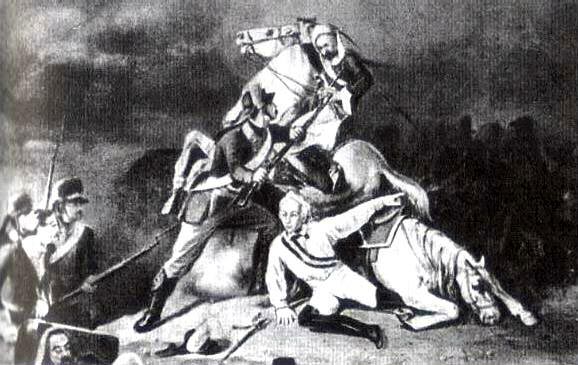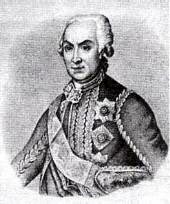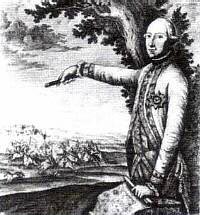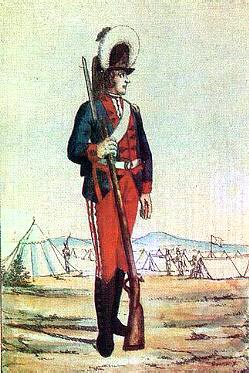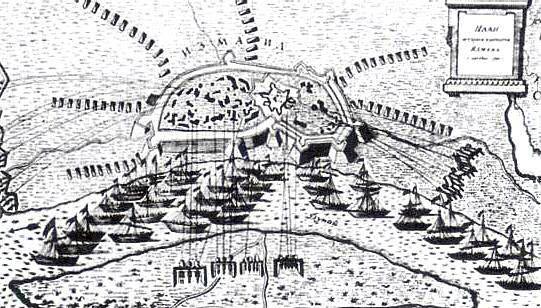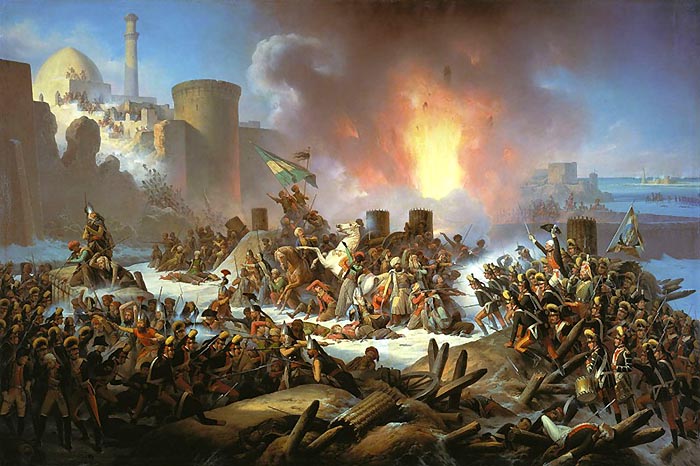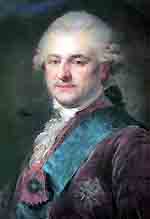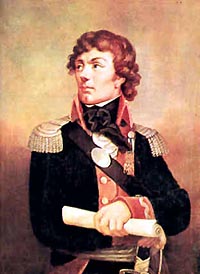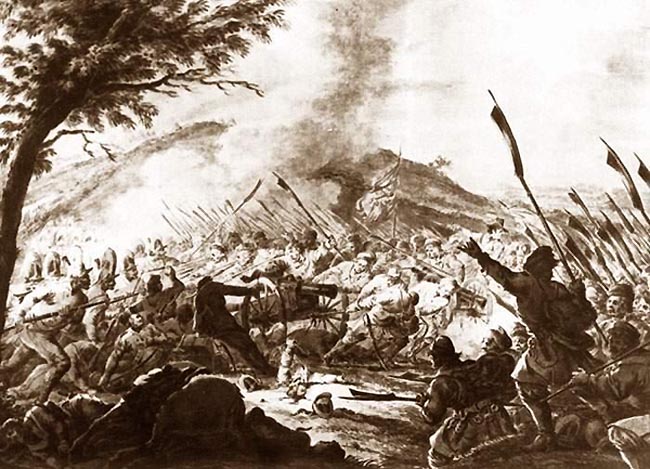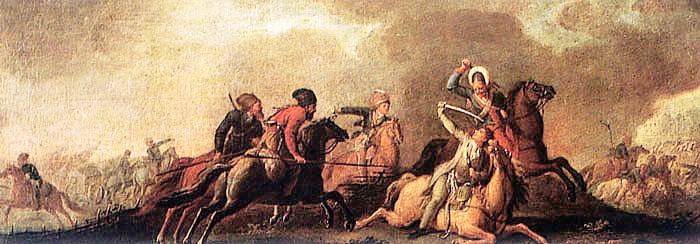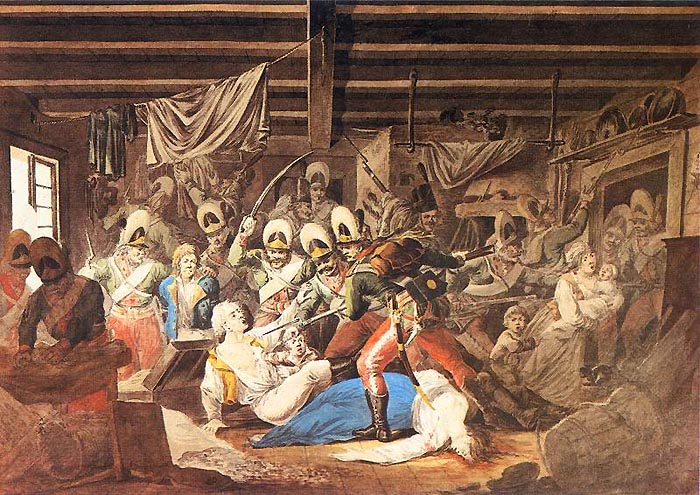Suvorov
In 1776-1779 Lieutenant-General Suvorov commanded the Russian forces in the Crimea and Kuban (a region in the Northern Caucasus). In the Crimea he strengthened the defence of the Crimean coast line in case of Turkish troops landing.
In 1782-1784 Suvorov commanded the detached Kuban Corps in the Northern Caucasus and directed the Kuban frontier fortified line building.
| The Second Catherinian Russian-Turkish War |
In 1786 Alexander Suvorov was promoted to the rank of general (General-Anshef - the highest general rank in the Russian army). He was appointed the commander of the Vladimir Division, then the St.Petersburg and Kremenchug Divisions.
The second Catherinian Russian-Turkish war of 1787-1791 began when Suvorov commanded the Kremenchug Division. And the star of his military talent rose just in this war.
General Suvorov commanded the defence of the Kherson-Kinburn region from the Southern Bug river to the Perekop neck (that connects the Crimean Peninsula with the mainland). Turkish troops threatened from the sea and the fortress Ochakov located across the estuary.
On October,1,1787 numerous Sultan's fleet landed strong troops on the Kinburn spit, they at once began to fortify themselves by lines of trenches. Suvorov attacked the Turks on the approaches to the Kinburn fortress. At first the Russian troops could pressed back the Turks to the end of the spit, but very soon they found themselves under the strong fire of the Turkish ship artillery and had to retreat under the charge of the new frsh Turkish forces. And at this moment Suvorov appeared in the middle of Russian troops and could organize a new counter-attack. There was a moment when Suvorov's life in danger: Suvorov was wounded and several janizaries rushed to him, but he was saved by a brave Russian grenadier.
|
|
Wounded Suvorov stayed on the battlefield and continued commanding his troops. The last reserves were committed to action and the last stage of the battle began. The Turks were finally dislodged from their fortifications and thrown down to the sea. In the end of the battle Suvorov was wounded again - in the arm, but he did not leave the battle in spite of all.
For this victory Suvorov was rewarded with the Order of Saint Andrew First-Called.
Fokshany and Rimnik
|
|
The long siege of the huge Turkish fortress Ochakov ended for Suvorov with the conflict between him and Empress Catherine's all-powerful favourite Prince Potemkin. Suvorov insisted on the general assault of the fortress in a very short time because during the very long siege the Russian troops sustained heavy losses of illnesses. So as a result of this conlict Suvorov took part only in some actions at the walls of Ochakov, but he didn't participated in the general storm on December,17 and returned to the Kinburn spit.
Next year Suvorov commanded a division in Prince Repnin's army.
1789 became the year of two most well-known Suvorov's victories: at Fokshany and at the river Rimnik. In the campaign of 1789 the main military operations were in the lower reaches of the river Danube where Russian troops acted tohether with their allies Austrians under Prince Coburg. Suvorov was sent there too to command troops of III Division. They were to support the right wing of the Russian Army and act in contact with the Austrians. Suvorov received reports about the moving of Osman-Pasha's army 30 thousand in number and hurried to the aid to the Austrian Corps located in Adguda village. On July,21 near the Foksany village the Russian and Austians under the common command of General Suvorov took the offensive, crushed the enemy van-guard, attacked the fortified Turkish positions and dislodged them from there after 10 hours of fighting. It was the complete defeat of Osman-Pasha's army - they had only to escape away.
|
|
The battle at the river Rimnik happened on September,11. Grand Visier Usuph-Pasha's army more than100 thousand in number with 80 guns waged an attack upon the Austrian Corps under Prince Coburg settled near Foksani village. Prince Coburg had only about 18 thousand men with 43 guns.
After getting known about this Suvorov with his detachment of 7 thousand men came out of Birlad and marched about 100 kilometers for two and a half days and nights. The Russian Corps came to Foksany earlier than the Turkish army.
Suvorov placed himself at the head of the Allied Russian-Austrian forces, he found out that Turks stopped and camped in four fortified places: near Tirgu-Kukuli village (about 15 thousand of van-guard troops), in the forest near Kringlu-Meylor village (about 40 thousand), near the town of Martinesti (about 45 thousand) and over the river Rimnik near the village Oday. The Russian general decided to defeat the Grand Visier's army separatedly in parts.
|
|
On September,11,1789 at daybreak the Allies after making a night march of 14 kilometers suddenly attacked the Turkish camp in Tirgu-Kukuli and captured it. The the Allies went to the forest camp in Kringlu-Meylor and assaulted it.
Osman-Pasha sent his cavalry of many thousands on attacking Allied troops, but all its attempts were repulsed by rifle-volleys from Allied squares, and the camp in the forest was taken be storm. Suvorov's troops pursued the enemy and captured the Turkish camp near Martinesti with a swoop.
The next day the Allies took the last enemy camp over the river Rimnik. Osman-Pasha with the remainer of his troops had to escape away. The Turkish army losses in this battle were about 15 - 20 thousand men, all artillery and the huge transport.
The battle at the river Rimnik came into Military History as a brilliant example of complex troops manoeuvring on the battle-field for the purpose of defeating the superior enemy in parts. The victory was gained as Suvorov used to say "Not by number - but by skill".
For the victory at the river Rimnik General Suvorov was rewarded with the Russian Empire highest military reward - the Order of Saint Geogre of the I Class and the title "Graf Rimniksky" (Count of Rimnik). And also the Austrian Emperor gave him the title of Count of the Holy Roman Empire.
The Capture Of Ismail
|
|
One of the most famous Suvorov's victories became the storm of the very strong Turkish fortress Ismail. This stronghold of the Ottoman Porte on the river Danube banks build by French and German fortificators was considered unassailable. In Turkish it was called "Ordu Kalesi" because this fortress could accomodate a whole army. It had the shape of an irregular triangle adjacent to the river bank. The length of the earthen rampart was more than 6 kilometers and the height was 6 - 8 meters with t earthen and stone bastions. The width of the fortress moat was about 12 meters with the depth of 6 - 10 meters. In many places the moat was filled with water. There were many stone buildings inside the fortress adapted to defensive actions.
The Ismain garrison was 35 thousand men and 256 guns. The commandant of Ismail was one of the most skilled Turkish commanders Aydos Mekhmet Pasha. The numerous Turkish Danube flotilla was based near the fortress walls. Russian troops (31 thousand men and more than 500 field guns) blocked Ismail and tried to capture it twice but without any success.
|
|
Under Suvorov's plan Ismail was stormed by 9 assault columns, three of that were based on the island Chatal and landed to the city from boats of the rowing flotilla. From dry land two groups of troops under Lieutenant-Generals P.S.Potemkin and A.N.Samoylov and Major-General M.I.Kutuzov attacked the fortress. Each column had its own reserves.
To avoid bloodshed Russian commander sent a letter to Aydos Mekhmet Pasha with the demand to surrender the fortress, but he refused decidedly.
On December,10,1790 Russian field and ship artillery bombarded the fortress. Next day (December,11) at 3 a.m. the assault columns began moving to their initial positions and at 5.30 a.m.the storm began. The Russians could not began storm in surprise and the attacking troops were met with strong artillery and rifle fire from the rampart. The Turks made a sortie. This fighting was especially hard for Don Cossacks armed with shortened lances.
After Russian troops had taken the fortress wall a heated hand-to-hand fight developed on the streets of Ismail. All the city was enveloped in flames. And at last after very hard and bloody battle Ismail was captured at about 4 p.m.
The Turkish losses were 26 thousand killed and 9 thousand wounded men, the Russian losses were 1815 killed and 2445 wounded men and the biggest losses were among officers because commanders went in front of the assault columns. The winners captured 265 guns (large-caliber in main), 42 river boats, 345 colours and bunchuks (Turkish standards).
The capture of Ismail brought Suvorov the glory of a great Russian commander, but he did not get the Field-Marshal baton, he got only the rank of colonel of the Leib-Guards Preobrazhensky regiment (in Russia in was a very high rank, Empress Catherine II herself had the rank of colonel of this Guards regiment too). The reason of this was Suvorov's terms with Prince Potemkin-Tavrichesky were very complicated.
In 1791 General Suvorov commanded the Russian troops in Finland and directed frontier fortifications building in case of war with Sweden.
| The Second Polish ("Insurrectional") War |
|
|
On May,3,1791 Polish King Stanislaw Poniatowski declared the new constitution. Under this constitution the kings electivity was abrogated, the upper strata of cities got access the the Seim (Parliament) and the central power was much strengthened. But the part of Polish nobles came out against it. The formed the "Targovitce" confederation and asked Russian Empress Catherine II for help. Catherine II announced Polish reforms as a direct consequence of the French "disturbance" and supported "confederates" against "patriots". In 1792 Russian army entered Warsaw and Prussian troops invaded the Western Polish provinces. In 1793 the second division of Poland was made.
It caused a big armed popular uprising all over Poland. Famous Polish hero and talented commander General Tadeusz Kosciuszko became the leader of the insurrection. Tadeusz Kosciuszko was a very well-known and popular person in Poland. In 1776 - 1783 he took part in the war for independence of the Northern American States as a volunteer. He distinguished himself many times, owing his military talent the American Army could win one of the most important battles at Saratoga in 1777. He was George Washington's aide-de-camp and got the rank of general and citizenship of the new republic.
|
|
Insurgents elected Kosciuszko their Commander-in-Chief. On their troops there were many common people, peasants that often were armed with pitchforks and scythes (because of it they were named "cosinieri", "cosa" in Slav languages means a scythe). They had to fight against well-armed and well-trained Russian and Prussian troops that outnumbered Polish troops very much. But the Poles fought heroically against the numerous invaders and could crush them in the first stage of the campaign.
The detachment of General Denisov sent by the Russian troops in Poland Commander General Igelstrom against insurgents was crushed by Kosciuszko at Raclawice village on March, 24, 1794. After it uprising developed in Warsaw and General Igelstrom with the rest of the Russian Warsaw garrison left the city and went to join the Prussian army (April, 5-6, 1794).
But the forces were too unequal. The Prussians joined the Russian troops and moved into Polish territory. On May, 25 their united forces defeated Kosciuszko's troops at Tscekocin and Warsaw was besieged soon.
|
|
However insurgents had recruited about 70 thousand soldiers and went to Lithuania, where the uprising developed with new force. But Russian troops defeated insurgents in several battles and on September,1 entered Vilno.
And just at this time Suvorov came to Poland. He was appointed the Commander-in-Chief of the Russian troops in Poland. On September,4 he with a detachment of 10 thousand men defeated the Polish troops of Serakovski at Krupchici village and hurled them to Brest. On September, 7 Suvorov crossed the river Bug and on September, 8 at Teraspol (in Poland) he finally crushed Serakovski's Corps.
Kosciuszko attacked Russian General Fersen's Division that was coming to join Suvorov's troops, but in the battle at Maciejowice village Fersen crushed the insurgents. In this battle Kosciuszko was heavily wounded and captured by Russian troops.
Then he was sent to St.Petersburg and prisoned into the Petropavlovskaya Fortress. When Paul I (Pavel) became the Russian Emperor in November, 1796 Kosciuszko was discharged by the new Emperor's order.
|
|
On October, 18 Suvorov approached to the strongly fortificated Warsaw suburb - Prague. On October, 24 after the very hard and bloody assault Prague was captured, and next day Warsaw was taken too. It this assault the Russian troops of Suvorov displayed shocking cruelty against Poles, about 20 thousand people were killed only in this subusrb, many of them were civilian people, women, children.
|
|
The second Polish campaign was finished. Russian and Prussian invaders have won. Next year King Stanislaw Poniatowski laid down his crown and the Polish Kingdom didn't exist anymore...
Such was this, one of the most unglorious pages in the Russian History and in the biography of the triumphant commander.
For the storm of Prague and this campaign Suvorov got the rank of General-Field-Marshal.

